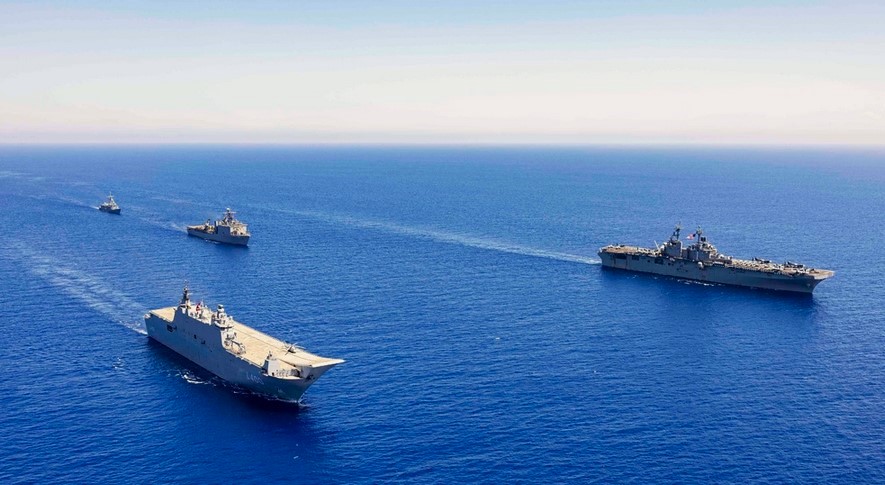
On the left in the foreground is TCG Anadolu, on the right in the foreground is USS Wasp, in the center background is USS Oakhill, and in the rear position is TCG Gökova.
President Tayyip Erdogan delivered a speech on August 24th at the Aksaz Naval Base in Marmaris, vowing to further strengthen Turkey’s navy and army. The impressive TCG Anadolu, Turkey’s first amphibious assault ship, served as a backdrop. Anadolu had just returned to Aksaz after participating in a joint military exercise with the United States in the Eastern Mediterranean.
While Erdogan emphasized protecting the “Blue Homeland” in his speech, the recent exercise with the US Navy, conducted from August 13-17, was not announced by the Ministry of National Defense, unusually. Turkish media only covered it after the US amphibious assault ship USS Wasp announced it on social media. In fact, CHP Deputy Chairman Yankı Bağcıoğlu criticized this lack of announcement, arguing that it revealed the government’s inconsistency in rhetoric and action regarding US relations.
This development takes on added significance when considered alongside outgoing US Ambassador to Ankara Jeff Flake’s statement in Politico: “When the world is at peace, Turkey is in an important position just because of geography. But when the world is an upheaval, then it’s all the more important”
Let’s examine this more closely.
What kind of exercise was this?
It appears to have been a ship-to-ship interoperability exercise between US and Türkiye which maintains navies with amphibious assault ships in the Eastern Mediterranean. The stated aim was to “deter aggression and ensure stability in the region.” As part of this, the V-22 Osprey special operations aircraft from USS Wasp reportedly conducted landing and takeoff drills on Anadolu’s deck. It’s unclear whether Turkish pilots performed similar helicopter drills on Wasp’s deck.
Wasp has been deployed in the Mediterranean since late June. It’s one of two American amphibious assault ships sent to the area as a deterrent against potential Iranian or Hezbollah attacks on Israel, while Israel’s military operation in Gaza continues, with Palestinian casualties now exceeding 40,000.
The other ship, USS Bataan, docked at Greece’s Souda Naval Base on Crete in February, conducting reconnaissance with approximately 4,000 special forces and marines. Just before its exercise with Anadolu, Wasp was in Cyprus’s Limassol port on August 8, carrying V-22s, vertical takeoff and landing-capable F-35 and A8 Harrier aircraft, and about 4,000 military personnel.
Beyond the Eastern Mediterranean
Reports indicate that en route, Wasp conducted a separate exercise with the USS Eisenhower aircraft carrier task force and the British missile destroyer HMS Duncan.
It’s also worth noting the NATO naval exercise “Breeze-Meltem,” which began on July 11 in Varna, hosted by the Bulgarian Navy. Participants included Black Sea nations Bulgaria, Romania, and Türkiye, as well as the US, Italy, and Greece. The exercise focused on coordinated alliance action in wartime, with particular emphasis on submarine warfare.
These interoperability exercises between allies should be seen as connected not only to Middle Eastern and Eastern Mediterranean dynamics but also to Black Sea tensions stemming from the Russia-Ukraine conflict.
Indeed, Ambassador Flake highlighted Türkiye’s role in facilitating a recent prisoner swap between the US, Russia, and Germany, hosted by MIT, despite current Türkiye-US tensions over Israel-Palestine and Syria-PKK issues. He also emphasized the long-term benefits of Türkiye’s ability to communicate with Iran and Hamas.
Notably, the Ambassador took this opportunity for self-reflection on the July 15 coup attempt, suggesting that “Putin acted swiftly, Obama was late, and this has stuck with us.”
Actions speak louder than words
While these comments seem conciliatory, the Ambassador’s words carry no binding effect for the incoming US administration to be elected on November 5. Similarly, there’s been no progress on new F-16s and other military equipment still withheld by the US (and other allies), despite the agreement on Sweden’s NATO membership.
Regarding our main topic, the USS Oakhill, a US landing ship, and the Turkish frigate TCG Gökova also participated in the “interoperability exercise” between Wasp and Anadolu in the Eastern Mediterranean.
Ankara’s decision not to announce the exercise with the US could be interpreted as a message: while fulfilling minimal alliance obligations, Türkiye remains skeptical of promises without concrete actions, particularly concerning Syria, Palestine, and military equipment sales.
There’s also a domestic political angle: publicizing a joint exercise with the US in the Eastern Mediterranean might have sparked public backlash, especially given the daily criticism of US policies – even if justified.
Considering the overall picture, I anticipate another success announcement from the Ministry of Foreign Affairs, Turkish Armed Forces, or MIT in the near future.
